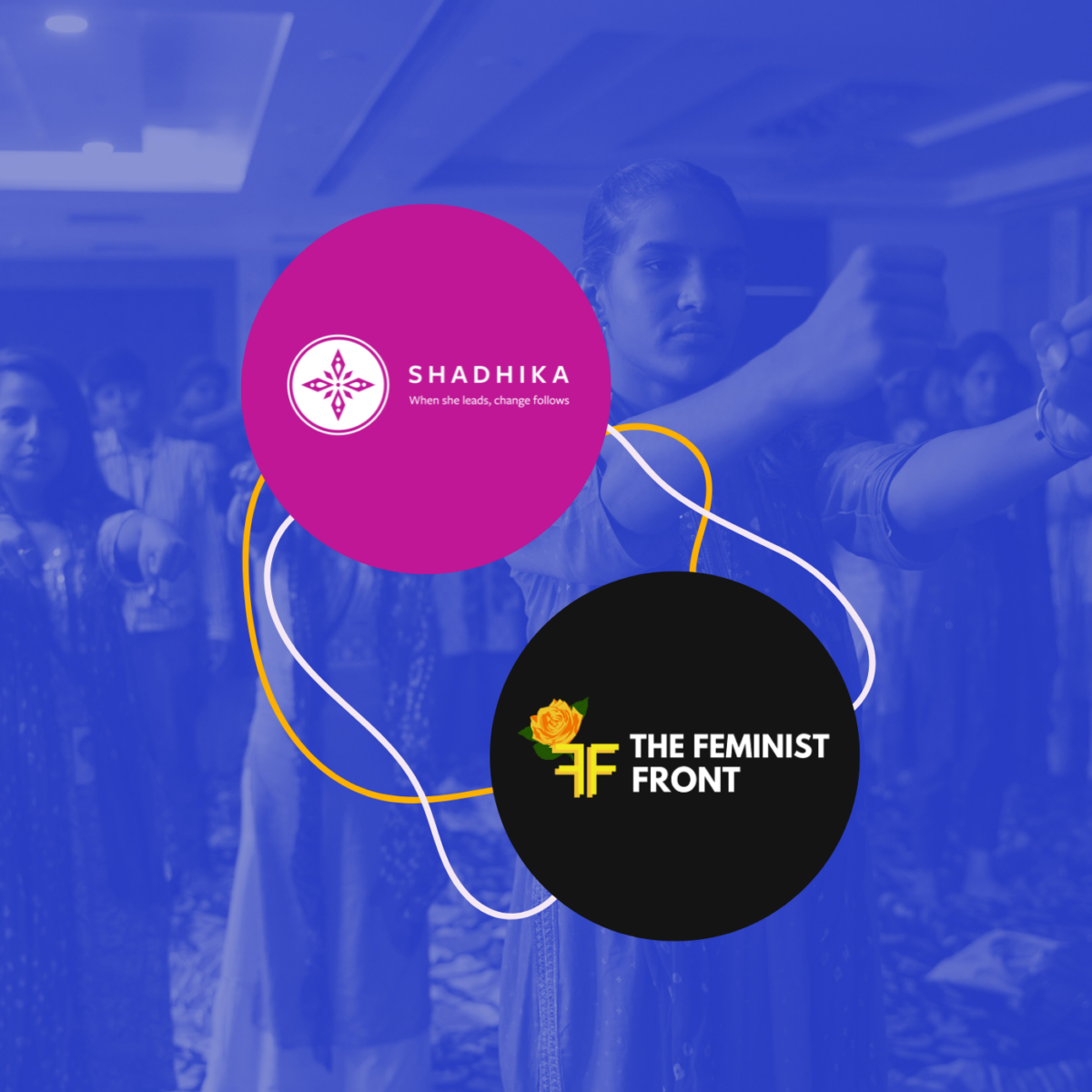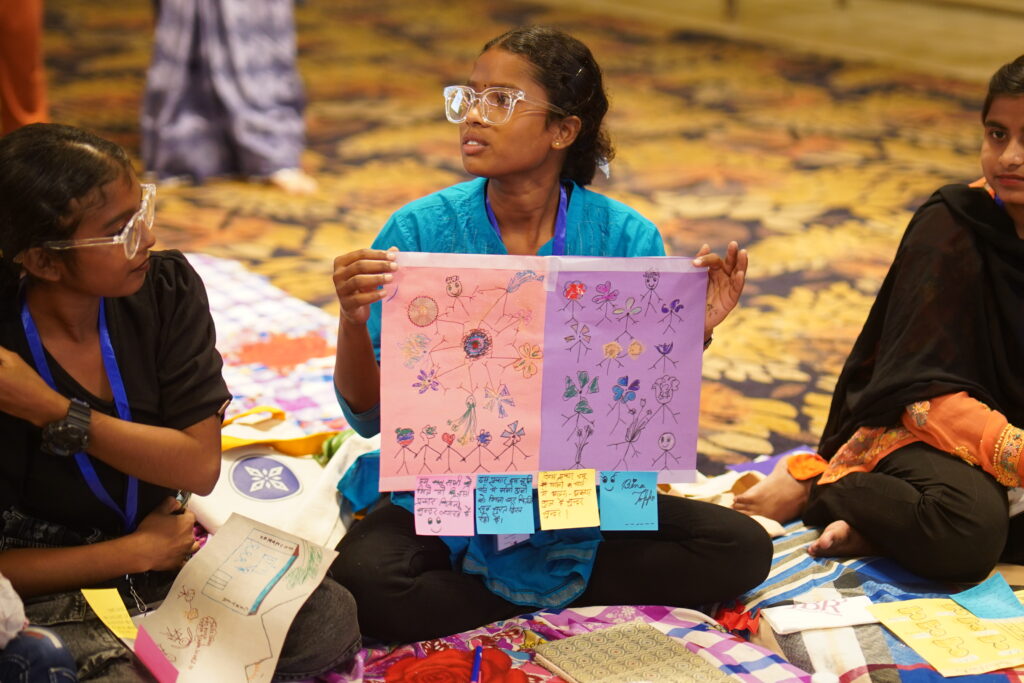
Collective action means that we are stronger together, and together, we stand in solidarity by supporting grassroots movements in every way possible.
Collective Art and Action: Part 1 of 2
By Urmila Reghunath, Communications Manager (India Consultant)
February 29, 2024
Reading Time: 6 minutesShadhika is hosting a virtual art exhibition featuring 25 works by Shadhika Scholars (Cohort of 2023) exploring their hopes and experiences of what collective action means for feminist leadership. Embodying the spirit of collective action shared through our exhibition, Shadhika has partnered with The Feminist Front (The FF) – a youth of color-led organization organizing 15-35 year olds for gender and racial justice in the U.S., to highlight the shared ways in which gender justice activists and youth leaders are working towards a feminist future around the world.
Read on to learn from RJ, the Operations and Communications Coordinator at The Feminist Front and Urmila, our Communications Manager (India Consultant) at Shadhika about the history and impact of collective action in the U.S. and India.
This blog post is being published in 2 parts. This is part 1. Click here to read part 2.
What does collective action mean for you?
RJ: At The Feminist Front our understanding of Collective Action comes from women of color queer and feminist theory like that of bell hooks that recognizes the need for collective struggle rooted in love in order to achieve collective liberation that does not prioritize a privileged few while leaving others in our movements behind. That work often looks like challenging structures of power and normativity rather than just pursuing assimilation into problematic and unjust systems that exclude and Other folks.
Making these ideas tangible we are working across issues that are often siloed by making the inexplicable connections between interlocking oppressions clear to more people. For example, exposing how abortion and gender-affirming care bans threaten bodily autonomy and further connecting this criminalization to systems of policing, incarceration, and state surveillance. We encourage collective action as we bring people together across differences in order to fight for bodily autonomy, equal protections under the law, transnational abolition, community power, and true liberation for all people one step at a time. One very important step on this journey is enacting protections against sex and gender discrimination like the Equal Rights Amendment (ERA).
UR: Shadhika believes that movements cannot be built in siloes, and that long-term transformation needs to be led by the wisdom and expertise of grassroots leaders. Through our local Program Partners, we have had the opportunity to witness the depth and far-reaching ripple effect of community-led innovations. Each of these leaders support and complement the efforts of their peer organizations, their communities, and other existing support structures.
This is the spirit of collective action – the understanding that injustice for one is injustice for all – and acting together towards the shared vision of a just world. And it doesn’t end there. Collective action means that we are stronger together, and together, we stand in solidarity by supporting grassroots movements in every way possible.

What is the context in which gender justice movements are working in your country?
UR: “Society always believes that no matter how educated a girl is, she is ultimately destined for the kitchen – to cook and care for her family,” explains Bina, a Shadhika Scholar.
Despite the advances in its economic and technological capabilities in recent years, India’s position has fallen drastically when it comes to gender gaps and ranks 140 of 156 countries in the The Global Gender Gap Index 2021 rankings. India’s neighbors Nepal, Bhutan, Sri Lanka and Myanmar all rank above India as per this report by the World Economic Forum. Young girls facing multiple systems of oppression are at an increased risk of early, forced marriage and gender-based violence in India which accounts for one third of the world’s child brides. Over 216.65 million women and girls were first married or in a union before the age of 18 in India and 29.3% of ever-married women aged 18-49 years in India have experienced spousal violence.
The Right to Education Act in India makes education a fundamental right for every child, assuring free and compulsory education for children aged between 6 and 14 years. And yet, gender gaps in income, mobility, and access to adequate infrastructure and technology mean that the average national female literacy rate is 70.3% compared to men’s literacy rate of 84.7%, with only one state out of 36 recording a female literacy rate above 90%. This is further exacerbated by the increasing instances of discrimination faced by communities marginalized due to their caste or religious identities.
In this context, grassroots organizations, civil society actors and community leaders are working through legal, social and infrastructural solutions for a gender just future. Importantly, these leaders on the ground understand the myriad complexities that determine one’s access to autonomy and opportunity, and are advocating for an intersectional, decolonized approach to policy making and development work.
RJ: While 85% of UN Member States have constitutional protections against sex and/or gender discrimination, the United States does not since politicians and courts continue to block efforts to publish and enact the Equal Rights Amendment. Due to a lack of federal protections against sex and gender discrimination nearly half of all U.S. states now ban or restrict Abortion and many forms of Gender-Affirming Care since the 2022 Dobbs decision by the US Supreme Court. State Equal Rights Amendments have protected abortion access and LGBTQ rights in certain states but the U.S. has no federal protections for abortion and bodily autonomy. Other efforts for gender equality in the U.S. lack the proper enforcement mechanisms and resources while the U.S. continues to grapple with a culture of misogyny and sexism. This culture of violence and disrespect for women includes the normalization of sexual violence and exploitation. As a result over 1 in 5 women in the U.S. report being raped or sexually assaulted at least once in their lifetime. Nearly 2 out of 3 transgender people in the US have experienced rape or sexual assault in their lives. Queer people in the U.S. report higher instances of sexual violence and intimate partner violence than their straight counterparts. In addition to the vulnerability and lack of protections for women and queer people, child marriage remains an active practice in the U.S. as well. Child marriage was legal in all 50 U.S. States until 2018, now in 2024 only 9 states currently ban the practice. According to Unchained at Last almost 300,000 child marriages occurred in the US between 2000 and 2018, often involving girls being married to adult men.
Read more
